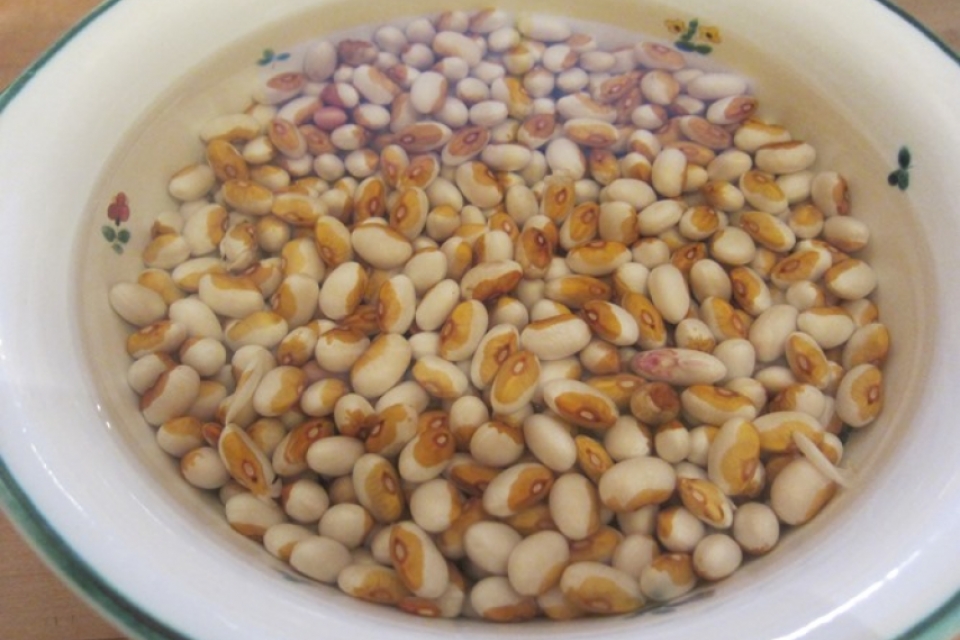Soaking Grains and Beans
This time of year, when the ground begins to soften, the buds swell on bushes and trees, and squirrels resume their frisky high-wire acts, is a wonderful time to think about treating our whole grains, beans, nuts, and seeds to a long, warm soak before we eat them. More than any other time of year, spring is a time when soaking seeds puts us in touch with the rhythms of nature, because it is happening all around us in the forest, fields, and flower beds.
All seeds contain phytic acid in the outer layer, which is there to keep the nutrients safely locked up inside until conditions are right for the seeds to soften and sprout. Seeds need 1) moisture, 2) warmth, 3) slight acidity, and 4) time in order to germinate, as anyone who has started seeds in the springtime will recognize. These conditions allow the development of phytase, among other enzymes, which neutralizes the phytic acid so the seed can sprout. When we soak beans and grains, we mimic these same conditions in order to release the nutrients before we eat them. After all, a seed's journey through the human digestive system is much shorter and simpler than through that of a cow or other ruminant animal, which has 4 stomach chambers and its own phytase to aid with this pre-digestion process! We humans have to do the early stages of food preparation outside of our bodies, and the best way to do that is to soak our grains and beans before gently cooking them.
Recently, I got to present on how to properly prepare some of my favorite bulk foods - grains, beans, nuts and seeds - at the NOFA-VT winter conference. We are so lucky to be able to purchase locally grown dried beans, whole grains, cornmeal, flour, and even occasionally rice at City Market. But in my workshop, I explained how the phytic acid in unsoaked seeds combines with minerals - like calcium, magnesium, copper, iron and zinc - to block their absorption, leading to a net mineral loss. Over time, a diet high in unsoaked grains can lead to mineral deficiencies, particularly if the diet is low in vitamins A, D, and K to help absorb available minerals (that's why eating a piece of cheddar cheese on a slice of sourdough bread or cooking a little pork with your beans is not just tasty, but advantageous from a nutrition perspective - they work synergistically to help maximize the absorption of the minerals). Soaking, like fermentation, also leads to an increase in lots of good, healthy enzymes and microorganisms like lactobacilli that break down hard-to-digest proteins and carbohydrates.
In an age when most people's caloric consumption comes from carbohydrates, and even federal food guidelines urge Americans to fill half their plate with whole grains, doesn't it make sense to look at how we are preparing these foods before we eat them? Soaking grains and beans is an easy entry to increase the nutrition content of existing foods in our diets, because we can take the foods we are already eating and simply prepare them more healthfullly. Institutions, take note! If you serve whole grains like brown rice or rolled oats, consider taking the extra step of soaking prior to cooking to lead to increased nutrition content, at no added cost!
So, how do we soak seeds for cooking? Generally, whole, cracked, and rolled grains (like wheat, spelt, rye, barley, etc.) are best soaked for 8-24 hours at room temperature in plenty of water with a little bit of acidity, for example:
1 cup whole grains
6 cups warm, filtered water
2-4 Tbs. yogurt, buttermilk, kefir, whey, vinegar, or lemon juice
You can rinse the grains to remove some of the acidity. If you do rinse the water, measure a little bit less water for cooking than you normally would, as soaking grains absorb some water. They will also cook a little faster.
And what about beans? Beans are not only high in phytic acid, they additionally have a hard-to-digest sugar called raffinose. Soak beans in plenty of water (3:1 ratio) for 12-36 hours, providing fresh water every 12 hours, for example:
2 cups dried beans
6 cups warm, filtered water
When it's time to cook them, simply drain, rinse, and place in a large pot with plenty of fresh water to cover beans. Cook until tender.
Nuts and seeds are best soaked in warm, salted water and oven-dried at a low temperature so they resume their crisp texture, or better yet, dehydrated.
4 cups raw nuts, such as walnuts, pecans, or almonds (or seeds, such as sunflower or pumpkin seeds)
2 tsp. sea salt (increase to 2 Tbs. for seeds)
Mix nuts/seeds with salt. Cover with warm water, mix well, and let sit in a warm place for at 7-24 hours. Drain in a colander. Spread on a baking sheet and place in a warm oven (150 degrees, or as low as your oven goes) or dehydrator, turning occasionally, until completely dry and crisp.
For more about soaking grains, beans, nuts, and seeds, check out Nourishing Traditions, 2nd ed. by Sally Fallon and Mary Enig, PhD, and some great traditional food blogs like The Nourishing Gourmet, The Nourishing Home, and Nourished Kitchen.
